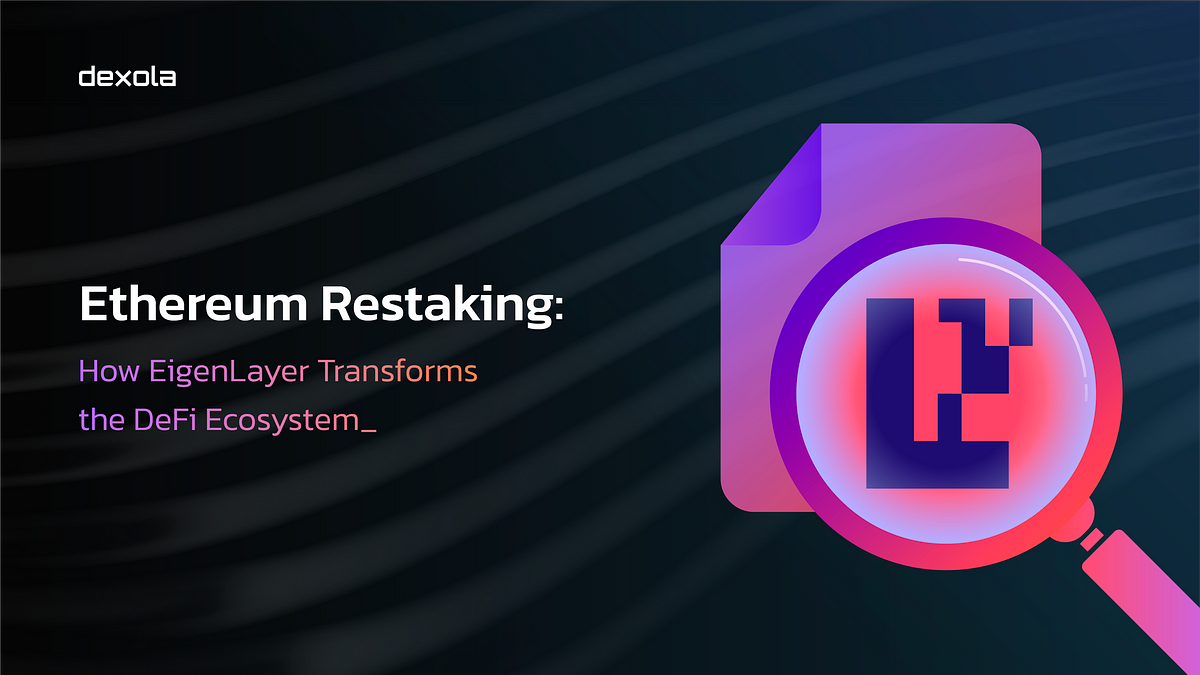Ethereum Restake: How EigenLayer is Transforming the DeFi Ecosystem | Posted by Dexola | Blockchain solution | Coins | March 2024
The concept of re-staking is very simple. You get the opportunity to stake the same asset to multiple different projects simultaneously, effectively doubling your potential profits. This isn’t a groundbreaking idea. Re-staking debuted in 2018 with the expansion of decentralized exchanges (DEXs).
In this article, we will look at the staking and re-staking process, explore how it can benefit the wider cryptocurrency ecosystem, and make some assumptions about its evolutionary trajectory going forward.
In 2018, Uniswap, a pioneering DEX, unveiled its Automated Market Maker (AMM) model along with liquidity pools. For these pools to work, DEX users had to provide liquidity by sending tokens to the pool’s smart contracts. This allowed different users to seamlessly exchange one token for another.
To facilitate this, DEX introduced liquidity provider tokens (LP tokens). By depositing assets into a liquidity pool, users received LP tokens representing their share of the pool. These tokens can later be returned to the pool to claim a portion of the accumulated transaction fees. This is how returns are calculated and distributed.
To encourage more deposits into the liquidity pool, DEXs invented farms. By staking LP tokens on these farms, liquidity providers can earn additional returns, usually in the form of the DEX’s native token or other assets.
Farms have been beneficial to both DEXs and liquidity providers. They ensured that liquidity was maintained within the exchange while providers enjoyed higher returns on their investments.
This symbiosis of liquidity pools and farms perfectly illustrates the basic idea of generating additional revenue from a single asset by leveraging it simultaneously in two or more different initiatives.
Ethereum restaking revolves around two core activities: You initially stake ETH on the Ethereum blockchain and then use the same ETH for other protocols or projects to enhance your cryptoeconomic security.
This approach emerged when Ethereum developers introduced a staking framework. ETH initially placed in staking contracts was fully locked until the Shanghai upgrade in April 2023. This setup was somewhat restrictive and caused considerable controversy, leading to the development of liquid staking protocols.
Liquid staking involves securing ETH in a specific contract in return for liquid staking tokens, or LST (e.g. rETH for Rocket Pool, stETH for Lido). These LSTs operate similarly to liquidity provider (LP) tokens in decentralized finance (DeFi), symbolizing the owner’s entitlement to exchange them back to ETH whenever they wish. Like LP tokens, LST can also be traded on decentralized exchanges (DEXs) and added to liquidity pools to earn additional revenue and bring benefits to the project.
Following these developments, several startup companies have now introduced comprehensive re-staking mechanisms, allowing previously staked ETH to be reused to enhance the security of other networks.
EigenLayer stands out as the best protocol for Ethereum re-staking, providing a powerful suite of smart contracts for both deposits and confirmations, as well as essential node software for managing the re-staking infrastructure. As of the latest update, EigenLayer boasts a total value locked (TVL) of $11 billion.
EigenLayer supports two retake modes:
- LST rebooking: This mode allows users to deposit Ethereum Liquid Stake Tokens (ETH LST) into pools that integrate with other proof-of-stake (PoS) protocols or decentralized applications (dApps) that require ETH staking. This is a rather simple concept, similar to LP tokens.
- Native ETH Restaking: Here, users can deposit standard ETH into special EigenPod contracts integrated with Ethereum and other protocols. EigenPod acts as a validator and obtains validator authority on Ethereum and other PoS networks.
EigenLayer is also exploring adding two re-staking options: ETH LP re-staking and LST LP re-staking. This future feature will allow you to stake ETH or LST previously allocated to liquidity pools within reputable decentralized exchanges (DEXs), lending platforms, and other DeFi projects that create LP tokens.
Overall, EigenLayer improves the usability and efficiency of Ethereum staking by facilitating diverse uses of ETH across multiple platforms simultaneously.
With multiple proof-of-stake (PoS) layer 1 (L1) and layer 2 (L2) networks built on top of the Ethereum Virtual Machine (EVM), the Web3 environment relies heavily on ETH for staking and ensuring network security. This requires significant amounts of ETH, which results in liquidity fragmentation across the platform.
Restaking allows users to pool their ETH and protect it at the same time. This is already a lot, but the benefits extend even further.
- Reduce capital costs for network security: By allowing current validators to distribute already staked ETH to a variety of services, there is no need to raise additional capital through re-staking.
- Improved network trust and security: The amount of value staked in a PoS network is directly proportional to the security and reliability of the network. For example, three separate networks could individually secure $1 billion of ETH, but pooling $3 billion of ETH across networks using a protocol like EigenLayer improves their collective security, trust, and user appeal.
- Opportunities to increase yield: The default ETH staking yield is 3-5% APY (a figure reflected in other EVM-compatible networks), but some large holders do not prefer staking and prefer to offer their ETH to more profitable protocols. Restaking allows holders to double or triple their returns without any additional risk.
- Accelerate value growth for new services: Restaking streamlines the development process by providing faster access to stake value for emerging services.
The Re-Staking Protocol also serves as the foundation for a variety of applications built on top of the Re-Staking Protocol.
At Dexola, we see that re-staking optimizes capital efficiency across the Web3 ecosystem, especially in the critical area of security.
Ethereum re-staking gives validators the opportunity to increase returns and increase security without increasing risk over traditional staking methods.
Today, EigenLayer is positioned as the strongest player in this specialty. However, as interest grows, additional re-staking platforms are expected to emerge to meet the growing demand.

